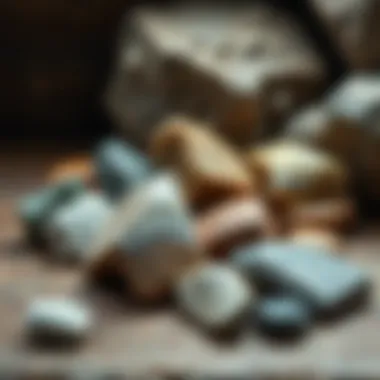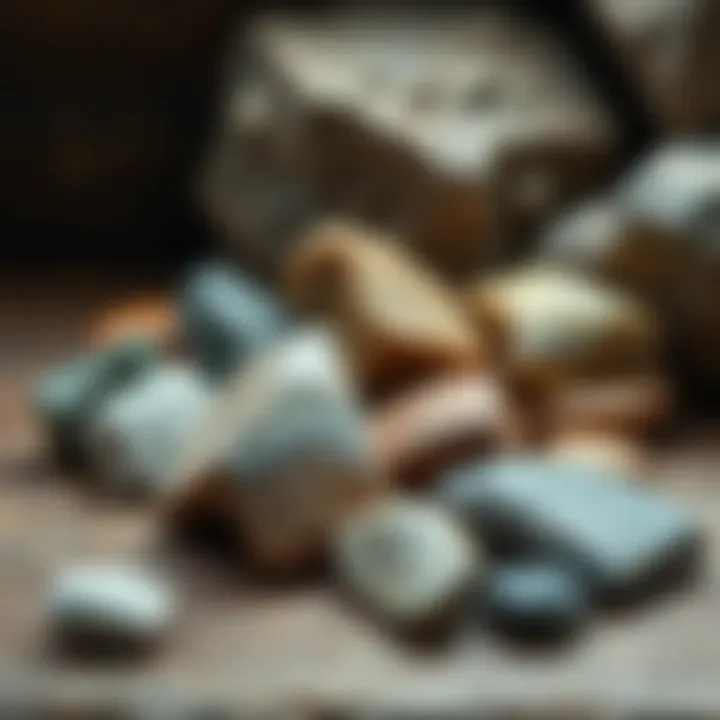Tumbling Rocks: Techniques and Insights into Geology


Intro
Rock tumbling is more than just a pastime; it’s a charming intersection of art and science that captivates many enthusiasts. Whether you are gazing at a lustrous piece of agate or holding a polished piece of quartz, there is a story waiting to be unraveled. Dive into the world of tumbling rocks, and you will discover the intricate process that transforms raw stones into gleaming treasures. Add to this the shared passion of a community, and it becomes an adventure of both personal discovery and connection.
History and Origins
Overview of Collectibles, Rocks, and Fossils
The allure of collecting rocks and fossils stretches back through time, with people captivated by the earth’s natural displays for centuries. Ancient civilizations often integrated stones into rituals and daily life, using them as tools, ornaments, and even currency. For example, the use of jade was prevalent in Mesoamerican cultures, where it held profound spiritual importance. Meanwhile, in the realm of fossils, early humans puzzled over these remnants of once-living creatures, leading to countless myths and legends.
Historical Significance and Cultural Impact
The narrative of rock collecting is woven into the fabric of many cultures. In the 18th century, the concept of geology began to take shape, propelled by figures like Georges Cuvier and James Hutton, who laid the groundwork for understanding our planet’s history. Their work paved the way for naturalists and collectors who ventured out into the wild, cataloging the wonders they found. The establishment of museums and collections highlighted the importance of geology to society, promoting education and fascination with natural history.
Identification and Classification
Guide to Identifying Rocks and Fossils
Identifying rocks and fossils is akin to piecing together a puzzle; it demands an understanding of characteristics, such as texture, color, and hardness. Often, rock hounds employ simple tests to classify specimens. Here are some practical tips to consider:
- Luster: Assess whether the surface is shiny, dull, or somewhere in between.
- Hardness: Use the Mohs scale of mineral hardness to test how well a rock stands against being scratched.
- Color: Observe base colors and patterns, as they provide significant clues.
With these methods, identifying the likes of obsidian, jasper, or even delicate trilobite fossils becomes more intuitive.
Common Types and Variations
When it comes to tumbling rocks, not all stones are created equal. Here’s a brief overview of some popular choices:
- Agate: This colorful banded stone is prized for its variety of hues and patterns.
- Jade: Valued for its beauty and cultural significance, jade comes in several shades, green being the most sought after.
- Granite: A tough option for tumbling; it boasts beautiful grain patterns.
- Sandstone: A softer choice, perfect for beginners starting out but requires patience.
Each rock type presents unique challenges and rewards in terms of tumbling.
“The journey of tumbling rocks is not just about the final glossy pieces; it’s about learning the stories behind each rock and the earth itself.”
Through this lens, collecting not only serves as a hobby but also as a deeper appreciation for geology’s vast complexities, inviting enthusiasts to expand their knowledge while savoring the tactile pleasures of polished stones.
Prolusion to Rock Tumbling
Rock tumbling is not just a hobby; it is a gateway into the intricate world of geology and creativity. For many enthusiasts, the simple act of transforming rough stones into polished works of art is deeply satisfying. But there’s more than meets the eye. Engaging in rock tumbling connects collectors to the Earth’s history and helps them appreciate the diverse compositions of natural minerals. As you dive into the process, you’ll discover not only the beauty of the stones themselves but also learn a lot about the geological principles that govern their formation and behavior.
Definition and Overview
Rock tumbling refers to the process where rough stones are placed into a tumbler, along with abrasives, and rotated for an extended period. This mechanical action gradually polishes the stones, resulting in smooth, shiny surfaces. It's a fascinating combination of geological processes and aesthetics that draws in individuals of all ages. Whether it’s the pursuit of a hobby or a more academic interest in geology, rock tumbling bridges these worlds.
Understanding rock tumbling involves three key elements:
- Preparation of Rocks: The right selection is essential to achieve optimal results. Different rocks respond differently to the tumbling process.
- Tumbler Mechanics: Knowing the types of tumblers and their functions is essential for success. There are various kinds on the market, each designed for unique tumbling needs.
- Tumbling Phases: The journey doesn't end with just tossing rocks into a machine. It requires careful timing through various stages, where rocks go through coarse grinding, fine grinding, and polishing.
The metamorphosis from rough to polished can take time, but the payoff is well worth it for those willing to take that journey.
Historical Context
The practice of tumbling stones harks back to ancient times, although the modern art of rock tumbling as we know it today began in the mid-20th century. Early collectors would hand-polish stones, a labor-intensive task that required not only skill but a keen understanding of stone types and their properties.
With the introduction of electric tumblers in the 1950s, the game changed. Suddenly, enthusiasts had the ability to polish rocks more efficiently, leading to a surge in popularity among hobbyists.
Rocks that were once left in their raw state were now gleaming jewels, ready for display or use in jewelry. Whether it’s agate, quartz, or jasper, modern technology has enabled enthusiasts to explore an ever-growing list of rock types. This evolution has heralded a new age in collecting, allowing individuals to share their passion through online communities and exhibitions. The melding of science and art has kept the fascination alive, encouraging new generations to indulge in this timeless pursuit.
The Science Behind Rock Tumbling
To truly appreciate the art of rock tumbling, one must delve into the science that makes it all possible. Understanding the fundamental principles of geology and the physical properties of the rocks themselves is not merely an academic pursuit; it’s a practical necessity for anyone hoping to achieve optimal results in their tumbling projects. The science behind rock tumbling offers a roadmap for selecting the right materials, using the proper techniques, and ultimately creating beautiful, polished stones that can serve as decorative pieces or cherished collectibles.
Geological Composition
Each rock’s journey begins with its geological composition. At the heart of this concept lies the understanding of how different minerals and structures contribute to a rock's behavior during the tumbling process. For instance, varieties of agate are composed primarily of silica, which gives them their characteristic hardness and vibrant colors. This composition not only influences how they tumble but also the final aesthetic appeal after polishing.
It’s fascinating to note that rocks like granite are intrusive igneous rocks that cool slowly beneath the Earth’s surface. This slow cooling allows larger crystal formations to develop, making them captivating to build collections around. Understanding the geological background of the rocks allows tumblers to select wisely, ensuring a rewarding tumbling experience while maximizing the efficiency of the process.
Physical Properties of Rocks
An in-depth dive into the physical properties of rocks reveals critical information necessary for successful tumbling. The primary aspects to consider are hardness, porosity, and surface smoothness, each playing a unique role in how a rock ultimately turns out once it’s completed its tumbling journey.
Hardness
The hardness of a rock, measured by the Mohs scale, directly influences how well it will polish in a tumbler. A harder rock resists scratches better, which is a vital characteristic when tumbling alongside other materials. For example, quartz, known for its durability, is a popular choice for beginners and experienced tumblers alike. Its notable hardness means it can withstand rigorous milling and polishing without breaking down too quickly.
Additionally, harder stones typically yield more prolonged tumbling periods, thus leading to a more polished and refined end product. This is particularly advantageous when aiming for pieces that exhibit a high degree of brilliance.


Porosity
Porosity refers to the amount of void space within a rock, which can impact the effectiveness of polishing. A rock's porosity can act like a sponge, absorbing the abrasive materials used in the tumbling process. While some porous rocks can present challenges, such as not achieving the desired shine, others can benefit from the process by retaining compounds that enhance color depth and richness.
For instance, jasper rocks, with their unique patterns, may have varied porosity levels, affecting how they respond during tumbling. Being aware of these differences can guide collectors in determining which rocks to use and how to adapt their techniques accordingly to maximize aesthetic results.
Surface Smoothness
Surface smoothness is arguably one of the most desired outcomes of rock tumbling. The tactile quality of a stone is the result of its tumbling history and how well it responds to successive phases of grinding and polishing. A smoother surface not only feels appealing but also allows for reflective qualities that enhance the stone’s natural beauty.
For example, the natural luster of polished onyx can be stunning but only if the surface is properly smoothed during tumbling. Uneven surfaces may not capture light well and detract from the visual appeal of the finished stone. Therefore, ensuring the right levels of finishing during the tumbling phases is paramount, as it directly influences the effectiveness of the polishing compounds used in the final stages.
Recognizing the interplay between these physical properties allows tumblers to tailor their techniques, yielding beautiful results that are as much about science as they are about aesthetic pleasure.
A solid understanding of the science behind rock tumbling propels collectors and hobbyists to new heights, allowing them to navigate the complexities of rock selection, tumbling techniques, and finishing touches with skill and nuance. This foundation not only enhances the tumbling experience but also enriches the joy of collecting and engaging with the natural world.
Identifying Rocks Suitable for Tumbling
Knowing which rocks to tumble can make or break your experience in rock tumbling. It’s not just about putting any stone in a tumbler and hoping for the best. Each type of rock comes with its distinct set of characteristics, which dictate how well they respond to the tumbling process. Choosing the right rocks not only enhances the aesthetic outcomes but also simplifies the learning curve for beginners.
When venturing through the realm of rock tumbling, it’s crucial to identify rocks that are not overly soft or too hard. A misstep here could lead to a pile of dust rather than beautiful, polished stones. Additionally, appropriate rocks can often yield stunning results, serving to motivate collectors to delve deeper into this fascinating hobby.
Popular Choices for Beginners
Agate
Agate is by far a favored choice among novice tumblers. This type of chalcedony is characterized by its banded structure and vivid colors. Agate’s composition makes it relatively durable, resisting breakdown during the tumbling process. Many beginners appreciate Agate for its ability to reveal intricate patterns once polished, stimulating an early interest in geology and mineralogy.
The unique feature of Agate lies in its variety; it comes in numerous colors and patterns, allowing collectors to choose according to personal tastes. Its moderate hardness makes it an ideal candidate, providing satisfactory results while still being forgiving enough for beginners to learn the ropes without disappointment.
Jasper
Next up is Jasper, another excellent pick for budding tumblers. This opaque stone is an aggregate of chalcedony and other minerals, resulting in a spectrum of colors and unique patterns. What sets Jasper apart is its ability to showcase vivid, earthy colors without the bands typically found in Agate.
Jasper’s resilience gives it an edge, as it tumbles well and polishes beautifully. However, it is necessary to keep in mind that not all Jaspers are equally hard; variations exist, and a softer type may yield less favorable results. The sheer variety present within Jasper allows beginners to experiment while also enhancing their collection.
Quartz
Quartz is another rock that comes highly recommended for tumblers, especially newcomers. This crystalline mineral boasts a high hardness level, making it capable of withstanding the rigors of tumbling without fracturing. Its clarity and brilliance when polished widely appeal to collectors, often leading to attractive pieces that can be used in jewelry.
The unique attribute of Quartz is its versatility; it comes in several forms, including clear, rose, and smoky varieties. While the durability of Quartz makes it relatively easy to work with, its high hardness means it can also wear down equipment if not handled properly. So, while it's a rewarding choice, it requires slightly more caution.
Advanced Selections for Experienced Collectors
As collectors progress, they may be drawn to more challenging specimens, which brings us to some selections suited for those with a bit more experience under their belts.
Flint
Flint is a sedimentary rock associated with the creation of tools in ancient times. Its toughness makes Flint an engaging choice for tumblers who wish to push their skills. Unlike softer stones, it requires a precise approach during tumbling due to the potential for cracking.
A unique feature of Flint is its conchoidal fracture pattern, which attracts many advanced collectors. The polished end product showcases a unique, glossy surface that can be jaw-dropping. However, one should note that the tumbling process may take more time and effort due to its density.
Granite
Granite’s appeal lies in its flecked patterns and colorful inclusions. A tough igneous rock, it offers a rugged challenge. For experienced tumblers, working with granite can yield pieces that are not only beautiful but also tell a geological story of their formation.
Since granite is dense and has varying hardness levels, tumbling it might require advanced techniques to achieve the desired finish. It’s crucial to be aware of this rock's nuances, as improper handling could lead to less than ideal results.
Onyx
Onyx is renowned for its striking beauty, displaying swirling patterns of contrasting colors. Its potential for captivating visual appeal makes it a tempting challenge for those who have honed their tumbling skills. Onyx is primarily composed of layers of chalcedony, giving it a unique luster.
One must approach tumbling Onyx with care as its banded nature can lead to potential fractures if not carefully managed. The advantage of working with Onyx is the spectacular, glassy polish it achieves, often resulting in show-stopping pieces suitable for display.
Lastly, while the thrill of tumbling unique specimens can be enticing, understanding the rock’s composition is key. This knowledge is not merely academic; it impacts the entire tumbling process, from pre-tumbling care to the final polish.
Essential Equipment for Rock Tumbling
The world of rock tumbling is not just about the rocks themselves; it’s also heavily reliant on the equipment that helps transform rough stones into smooth, polished pieces of art. Having the right tools is essential for achieving desirable results, and it can greatly influence the overall tumbling experience. Understanding different types of tumblers and the accompanying materials will equip you with knowledge to make informed choices. This section elucidates the vital equipment necessary for rock tumbling, highlighting the benefits and considerations for beginners and seasoned collectors alike.
Types of Tumblers
Rotary Tumblers
Rotary tumblers are often considered the backbone of rock tumbling. One key characteristic of these machines is their drum-shaped design, which rotates around a central axis. This motion brings about a grinding action that works on the rocks, smoothing their surfaces gradually over time. Many enthusiasts appreciate rotary tumblers for their ability to handle a larger batch of rocks, making them a favorable choice for those who are just starting out or individuals looking to process several pieces simultaneously.
One unique feature of rotary tumblers is their ability to produce a consistent finish on the rocks through a multi-phase process. This typically includes coarse grinding, followed by fine grinding and polishing phases. However, they do have a drawback: the processing time can be longer than other options, often requiring several days to weeks, depending on the hardness of the rocks being tumbled. Nevertheless, for collectors who are patient and meticulous, rotary tumblers represent a solid investment.


Vibratory Tumblers
Vibratory tumblers, on the other hand, offer a different approach to rock tumbling. They work not by rotation but through vibrating motion that moves the rocks against each other and the media inside the drum. This technique enables them to polish rocks faster than rotary tumblers, typically within a few hours to a couple of days. A noteworthy characteristic that sets vibratory tumblers apart is their efficient design; they often require less time than rotary tumblers to achieve a satisfactory finish.
However, this speed comes with a consideration. Vibratory tumblers are generally better suited for pre-shaped rocks or stones that are already relatively smooth. While they can indeed provide a nice shine, they might not be as effective with extremely rough stones needing extensive shaping. So, for those more experienced in rock tumbling, having a vibratory tumbler can complement the rotary option for varied tumbling needs.
Supporting Materials
Grinding Media
The grinding media is crucial in the tumbling process, serving as an abrasive element that aids in shaping and smoothing the rocks. Common options include ceramic media, which is well-regarded for its hardness, and plastic media, favored for being lighter and less aggressive on softer stones. One critical benefit of using grinding media is how it enhances the grinding process, ensuring rocks don’t get damaged excessively during tumbling.
The unique feature about ceramic media is its durability; it can withstand the rigors of prolonged tumbling sessions. However, it can also be heavier and require careful handling to avoid abrasions on the more delicate stones. On the other side, plastic media is gentler and can mold to the shape of the stones. But being less abrasive, it may take longer to reach desired outcomes compared to its ceramic counterpart.
Polishing Compounds
Polishing compounds are the final touch in a rock tumbling process, and they are just as vital as the tumblers and grinding media. These compounds work to enhance the shine of the stones after they’ve been ground and smoothed. Some popular types include diamond polishing pastes and aluminum oxide powders. The right polishing compound can truly make a stone pop, bringing out the inherent colors and patterns that often go unnoticed in rough stones.
One key characteristic of diamond polishing pastes is their effectiveness on various materials, making them a versatile choice for collectors handling different types of rocks. However, they tend to be pricier compared to other options. Conversely, aluminum oxide is an economical choice and delivers decent results, best used on softer or less expensive materials. Ultimately, the choice of polishing compound should reflect both budget and desired shine quality.
"Choosing the right equipment and materials is foundational for anyone looking to delve into the rewarding hobby of rock tumbling. The success of tumbling efforts rests heavily on this selection."
Tumbling Process Explained
The tumbling process is the heart and soul of rock tumbling. It plays a pivotal role in transforming rough stones into smooth, polished gems. This section sheds light on why understanding the nuances of this process is crucial for anyone in the rock tumbling hobby. A solid grasp of the tumbling phases helps you achieve stunning results and enhances the overall experience of turning ordinary stones into something special.
Preparation of Rocks
Before you toss those jagged rocks into the tumbler, preparation is key. This step isn't just about cleaning; it's about selecting and sizing your rocks appropriately. A good starting point includes washing the stones to remove any dirt or dust accumulated from nature's elements. This ensures that nothing will interrupt the grinding process or damage the tumbler itself. It's also wise to group rocks based on their hardness and size, as mixing stones that are too different can lead to uneven results.
Tumbling Phases and Timing
This is where the magic truly happens. The tumbling process involves several distinct phases, each contributing to the final outcome of the rocks.
Coarse Grinding
Coarse grinding forms the first stage and lays the groundwork for the entire tumbling process. During this phase, the primary goal is to shape the rocks and remove any major imperfections. Coarse grit works like a charm here, quickly wearing down rough edges and ensuring that all stones are more uniformly shaped. This phase is especially crucial because it sets the tone for everything that follows. If you don't give this stage the proper attention, you're likely to end up with a less appealing finish. However, one must be cautious: overdoing it can lead to excessively worn stones, which can be a disadvantage if you plan to keep the shape. Generally, this phase can be completed in 7 to 10 days, depending on the hardness of the stones.
Fine Grinding
Once your rocks have undergone coarse grinding, it’s time for fine grinding. This phase refines the shapes attained in the previous step, smoothing out tiny scratches and imperfections that remain. Using a finer grit helps enhance the visual appeal of the stones, bringing out their natural beauty. A distinct characteristic of fine grinding is how it prepares the stones for the polishing stage. It’s often a favorite among collectors, as the rocks begin to take on that glossy finish we all admire. However, achieving the perfect balance in this phase requires patience; too quickly and you might leave scratches, too slow and you could waste time and grit.
Polishing
The polishing phase is what rock tumblers look forward to the most. This is the stage that can take a basic-looking stone and turn it into a lustrous, eye-catching masterpiece. Polishing compounds work to fill in any remaining scratches and enhance the stones’ colors. What makes polishing unique is the transformation that is not only visible but tangible as well. The stones, once rough and gritty, feel smooth to the touch, radiating beauty from every angle. The key characteristic here is timing; it takes a fine balance to ensure a super shine without over-polishing, which might lead to potential wear. Typically, this last phase takes around 5 to 7 days.
"The journey of transforming rocks into polished gems is not just a process; it's a connection to nature and an art form in itself."
Each of these phases is progressively reliant on the previous one. Neglecting any could lead you to a disappointing result, which is why honing each step is vital for every rock tumbler, whether you're a novice or seasoned pro. Understanding the timing and choreography of these processes is what differentiates the amateur from the expert, guiding each collector in their unique journey toward refining their stone treasures.
Maintaining Your Tumbling Equipment
Maintaining your tumbling equipment is key to ensuring a successful rock tumbling experience. Regular upkeep and care not only prolong the life of your tumblers but also enhance the results of the tumbling process. Whether you're a novice collector or a veteran in the field, neglecting this fundamental aspect could lead to poor outcomes and frustration. Additionally, routine maintenance helps to promote safety during operation, ensuring that nothing goes haywire when you're in the thick of things.
Cleaning and Care
Keeping your tumbling gear clean is akin to keeping a fine watch; precision and clarity come from attention to detail. After each batch of rocks is tumbled, it is critical to perform a thorough cleaning of both the tumbler barrel and the grinding materials. Over time, dust, grit, and residue can accumulate, which can affect performance. Start by disconnecting the tumbler from its power source. Then, remove the barrel and rinse it under warm water, scrubbing gently with a soft sponge or cloth to remove any residue. If needed, a mild detergent can help break down tougher grime without damaging the surface. Be sure to dry the barrel completely before reassembling.
Regularly check and clean the drive belt and motor too. Dirt and dampness can lead to slipping or, worse, engine failure. A simple wipe can go a long way in preserving the mechanism's functionality.
"A clean machine is a happy machine."
Besides cleaning, keep an eye on the overall condition of all parts. Wear and tear can creep up on you, especially if you're on a good rock rolling spree. Make a habit of checking for cracks or breaks in the barrel, as these can lead to leaks and affect the tumbling process. Don’t forget, a little preventative maintenance can save you a headache later down the line.
Troubleshooting Common Issues
As with any machinery, hiccups can happen when tumbling rocks. It's important to be able to diagnose issues quickly to avoid setbacks. Some common problems you might face include unevenly tumbled rocks, loud grinding noises, or even the tumbler stopping mid-cycle.
- Uneven Tumbling: If you find your rocks are not being smoothed uniformly, this might be caused by overloading the barrel. Ensure you're following the recommended capacity for your specific tumbler model, as overstuffing can lead to inadequate movement within the barrel. Changing the variety of rocks in a batch can also help; mixing softer stones with harder ones could yield better results.
- Loud Noises: Excessive noise can often indicate issues with the drive belt. If it is too tight or has become misaligned, you might hear grinding or squeaking sounds. Check if the belt is correctly positioned and adjust it slightly if necessary. If the noise persists, replacing the belt may be the way to go.
- Tumbler Stops: If the tumbler unexpectedly halts, first check if the motor has overheated. Ensure it has appropriate ventilation and isn’t clogged up with dust. Reset after letting it cool down; if issues still arise, inspecting the motor and checking the power supply may help pinpoint the issue.
By being proactive in your maintenance routine and troubleshooting efforts, you can enhance your rock tumbling journey greatly. Connect with communities such as Reddit or local clubs to share insights and experiences related to equipment care.
Staying informed and engaged with fellow enthusiasts can shed light on best practices and solutions for any equipment-related questions you may have.
Showcasing Your Finished Rocks
Showcasing your finished rocks is more than just a matter of aesthetics; it’s a celebration of the time, effort, and passion that went into bringing those raw natural treasures to life. After completing the tumbling process, it’s tempting to simply toss your polished pieces in a drawer or box. However, displaying them properly can significantly enhance their visual appeal and deepen your connection with your hobby. Whether you are an experienced collector or a newcomer, the way you showcase your rocks can tell a story about your journey in geology and collecting.


The benefits of showcasing your finished rocks are manifold. First, it allows you to appreciate the beauty and diversity of each specimen you've worked on. The intricate patterns, colors, and shine that emerge through tumbling can be stunning, and displaying them encourages gratitude for nature’s artistry. Second, a well-curated display can help spark conversations with friends and family, inviting others into the fascinating world of rock tumbling. Lastly, showcasing your collection contributes to preserving your passion and can serve as motivation to keep exploring and collecting more.
Creative Display Ideas
To truly bring out the uniqueness of your finished rocks, consider employing a variety of display ideas that cater to both space and personal style. Here are some creative suggestions:
- Shadow Boxes: These provide a three-dimensional display where you can organize rocks by type or color. Shadow boxes also protect your collection from dust while allowing light to enhance their luster.
- Glass Jars: Simple glass jars can become a lovely centerpiece. Fill them with a selection of polished rocks—larger ones at the bottom and smaller ones on top to create depth and interest.
- Natural Elements: Incorporating elements like driftwood or fossilized wood into your display allows rocks to blend with natural textures. This adds a touch of the outdoors indoors.
- Custom Shelving: Installing floating shelves or a personalized wooden display can give your collection a gallery-like feel, keeping your polished gems in prominent view.
- Artistic Arrangements: Pair your finished rocks with other minerals, or create themed displays based on location or rock type. This storytelling aspect can draw viewers in.
Each of these ideas not only elevates the visual impact of your rocks but also allows for ongoing interaction with your collection. You can rearrange or update these displays as you acquire new pieces.
Sharing with the Community
Engaging with the rock tumbling community is another rewarding aspect of showcasing your finished pieces. It’s not just about exhibit; it’s about connection and contribution to a shared passion. Here’s how you can get involved:
- Social Media Platforms: Join groups on Facebook or Reddit dedicated to rock tumbling. Sharing pictures of your polished rocks can spark discussions, tips on tumbling techniques, or inspirational stories from fellow enthusiasts.
- Online Forums: Platforms like rocktumblinghobby.com offer forums where collectors can post their work, ask questions, and share resources. Constructive feedback can lead to learning and better results in future batches.
- Local Clubs: Checking your local area for mineral or rock clubs can be invaluable. They often host events where you can display your collection alongside peers. This can also serve as a great platform for swapping rocks or sharing advice.
- Exhibitions and Shows: Participate in local craft fairs or rock shows. Getting involved in exhibitions exposes your work to a broader audience and can lead to new friendships and partnerships with other collectors.
These connections not only enhance the joy of collecting but also foster a sense of belonging in a community that shares your enthusiasm for the earth’s hidden gems.
Ultimately, how you showcase your finished rocks can reflect not just personal taste but also your journey as an avid collector. In the end, whether it is through creative displays or vibrant community engagement, your polished treasures deserve to shine.
The Community of Rock Tumblers and Collectors
The world of rock tumbling and collecting extends far beyond just the act of polishing stones. It encompasses a vibrant community of enthusiasts who share their passion, knowledge, and experiences. This community is invaluable for both novices discovering the intricate beauty of geology and seasoned collectors honing their craft. By engaging with fellow rock tumblers, individuals can gain insights, resources, and camaraderie that significantly enhance their journey in this timeless hobby.
One of the most notable aspects of being part of this community is the access to knowledge. Newbies often have questions, whether about the best types of rocks to start with or how to troubleshoot equipment. In a community like this, those questions are not only welcomed but encouraged. The collective experiences of its members can provide answers that go beyond what any book might offer. From practical tips to lore about specific mineral formations, the wisdom shared among members can be truly enlightening.
Moreover, sharing is a two-way street. It's common for enthusiasts to give back to the community by posting detailed guides, video tutorials, or even organizing workshops. This fosters an atmosphere of mutual support, which is crucial in building connections and friendships. When people unite over a common interest, it can turn into something much deeper than just rock polishing. Those relationships can last a lifetime.
"In our community, every rock tells a story; it's about more than just collecting—it's about connecting."
Additionally, the community brings about a sense of motivation and inspiration. Seeing what others have accomplished can spark new ideas and drive individuals to push their own boundaries. Whether it's a particularly difficult tumbling technique or a stunning display of polished rocks, witnessing another's success can encourage one to take the next step in their own journey.
Forums and Online Groups
The rise of technology has made it easier than ever for enthusiasts to connect, regardless of geographical boundaries. Forums and online groups provide a platform for discussions, sharing tips, and showcasing findings. Websites like reddit.com have specific communities where users post their experiences, ask questions, and seek feedback on their collections. These online spaces are excellent for getting quick answers or discovering trends that are popular among rock tumblers around the world.
Another great aspect of these online circles is their ability to host specialized interest groups. For instance, collectors focusing on specific minerals or regional rocks can find like-minded individuals to share insights with. These niche forums can become valuable resources, offering expert advice and sometimes even local rock hunting tips.
Online interactions also blossom into in-person friendships. Many enthusiasts start by chatting in forums before meeting at events or local collections.
Local Clubs and Events
Joining local clubs and attending events provides tangible benefits that a digital platform cannot replicate. Being physically present with fellow enthusiasts lends a sense of belonging and community. Local clubs often organize field trips, allowing members to explore actual rock formations and hunt for potential tumbling candidates in their natural habitats. This hands-on experience not only builds friendships but greatly enhances one’s geological knowledge.
Events such as rock fairs or gem shows expose collectors to a wider array of specimens than what might be found in one’s backyard. Attending these gatherings can make for unique experiences where one can learn, trade, or buy various rocks and supplies. It’s truly a treasure trove!
Ecological Considerations in Rock Tumbling
When diving into the intricacies of rock tumbling, it's crucial to understand the ecological landscape that surrounds our beloved hobby. The act of collecting and tumbling rocks is not just an engaging pastime; it carries weighty implications for the environment. By acknowledging these factors, enthusiasts can protect and preserve the natural beauty we all cherish. Understanding ecological considerations ensures that our passion doesn't come at the planet's expense, promoting a symbiotic relationship with nature.
Sustainable Practices
Adopting sustainable practices in rock tumbling is akin to putting on a pair of sensible shoes before a long hike. It aids in leading the way toward a more harmonious existence with the Earth. Here are some vital practices that can help collectors reduce their environmental impact:
- Mindful Collecting: Only collect rocks in areas where it is permitted. Many locations have regulations to protect their natural resources. Ignoring these laws can lead to devastating consequences for ecosystems.
- Leave No Trace: After collecting, ensure that the area is left as you found it. This mindset helps preserve the surroundings and allows future collectors to enjoy it, too.
- Use Eco-Friendly Materials: In the tumbling process, utilizing non-toxic and biodegradable polishing compounds can drastically reduce harmful impact on local waters and soils.
- Participate in Restoration Projects: Engaging in local restoration projects can be a fulfilling way to give back to nature. Joining forces with organizations dedicated to ecological health reinforces the idea that collectors care about the environment.
By weaving these practices into their routines, collectors can protect the ecosystems that make rock tumbling possible. It's a simple reminder that our hobby should enrich the world, not deplete it.
Ethics of Collecting
When it comes to rock collecting, ethics play a pivotal role in shaping how enthusiasts interact with our planet. Whether one is gathering agate along a riverbank or sifting through gravel at a construction site, it’s essential to consider the broader implications of these actions. Here are critical elements related to the ethics of collecting:
- Respect for Nature: Rocks are part of the Earth’s intricate tapestry. They take millions of years to form, and uprooting them indiscriminately can lead to irreversible damage. Approach collecting with respect and care for natural materials.
- Understand Cultural Significance: Many sites hold immense historical and cultural value, especially for Indigenous peoples. Before collecting, it’s good to be aware of the significance of these locations and seek permission if necessary.
- Avoid Commercial Exploitation: Posting online for some high-ticket items may be tempting, but it can lead to over-collection and depletion of natural resources. Instead, focus on the joy of collecting rather than the monetary gain.
- Spread Awareness: Share knowledge about ethical collecting practices within the community. Encourage fellow enthusiasts to consider the ecological and ethical dimensions of their actions.
In essence, upholding ethical standards enriches the experience of rock tumbling and contributes to the preservation of our shared ecosystem.
"We do not inherit the Earth from our ancestors; we borrow it from our children."
– Native American Proverb
Closure
The journey through the world of rock tumbling has been an enlightening exploration of both the artistic and scientific principles that come together in this captivating hobby. It allows enthusiasts to connect with nature on a deeper level, encourage sustainability while collecting, and appreciate the beauty hidden within unassuming stones. Through the various sections discussed in this article, the aspects of tumbling—ranging from suitable rock types to essential equipment—have shown that rock tumbling is more than just a task; it’s a transformative journey.
The Lasting Appeal of Rock Tumbling
Engaging in rock tumbling cultivates a unique blend of patience and satisfaction. The visual metamorphosis from rough gems to polished beauties is an experience that resonates with many collectors. It's not only about the final product—though a gleaming agate or a vibrant jasper certainly boasts charm—it's the journey of working through different phases of the tumbling process that's equally rewarding.
"Rock tumbling teaches us that great things take time, just like life itself."
Many find solace in the rhythm of the tumbler, connecting with each rough rock as if it were a story waiting to be told. Rock tumbling also offers a communal aspect. Local clubs and online forums bring people together, allowing for knowledge sharing and fostering friendships based on shared passions. This blend of individual creativity and community engagement further enhances the overall appeal of rock tumbling.
The thrill of discovery cannot be overlooked. Tracking down new rocks, learning to identify their qualities, and understanding their geological history lends a richness to the experience. For those dedicated to the craft, there’s always something new to uncover—whether it's a unique stone or an advanced tumbling technique.
Ultimately, the longevity of rock tumbling can be attributed to its ability to cater to diverse interests, whether for those seeking relaxation, creativity, or a scientific curiosity. Understanding the implications of one’s collecting practices fosters a sense of responsibility towards nature, enhancing the overall experience of this fulfilling hobby.



